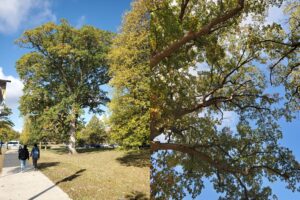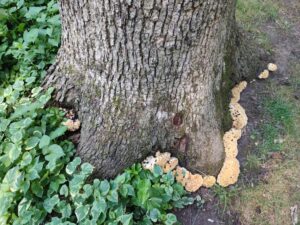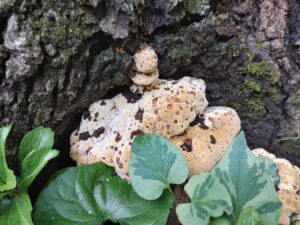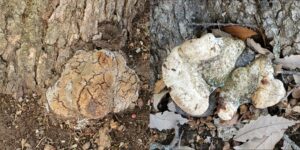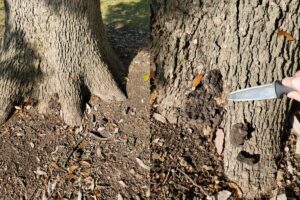Inonotus dryadeus is one of the more common wood decay fungi we receive at the diagnostic lab in association with declining trees, specifically oaks. Inonotus is found so frequently on oaks it has the common name oak bracket fungus, but it can cause root rot of a number of other hardwood trees (including maples, sweet gum, buckeyes, chestnut, and ash) and conifers (fir, pines, spruce, and hemlock – mostly in western US).
Similar to other butt and root rots of trees, Inonotus causes internal decay near the base of the tree. Trees may not show any external symptoms while there is a raging root rot decaying everything holding it up, eventually leading to an unexpected failure of the tree during a windstorm. Trees with compromised root systems may also die suddenly during hot and dry weather. Most often, we see a gradual decline of infected trees with stunted growth, limb dieback, and/or sparse, off-color foliage; symptoms that may accelerate during adverse environmental conditions (Figure 1).
- Figure 1: Mature oak tree known to be infected by Inonotus dryadeus on Purdue University West Lafayette campus. Right image shows limb death suggestive of tree decline.
The only good thing about this fungus is that it is somewhat easy to identify. Inonotus produces a round to irregularly-shaped conk like structure each year from colonized host tissue, such as exposed roots, the trunk at the soil-line, or lower trunk (Figure 2). When it is young the conk is yellow to orange on the upper surface and white on the underside. Pores in the upper surface of the conk producing amber colored liquid can also be found earlier in the spring and early summer, lending to its other common name the weeping conk (Figure 3).
- Figure 2: Extensive growth of Inonotus dryadeus from the base of an oak tree. The tree had significant limb dieback, was at risk of falling over, and subsequently removed.
- Figure 3. Inonotus conks with amber droplets on their upper surface.
In late July going into August, the conks begin to lose some of their glimmer and they become a duller orange-brown color and visibly dry out, often developing cracks in their surface (Figure 4). Conks from previous years may also be found near the base of the tree as they become crusty and black with age (Figure 5).
- Figure 4: Mature conks drying out in early fall. Note the large cracks developing in its exterior.
- Figure 5: Dead conks that are still attached to an ailing oak tree. Conks are shriveled, black, and completely desiccated. These can also be readily found on the ground around the base of an infected tree.
Inonotus is regarded as parasite of living oak trees so it appears to be more aggressive than other wood decay fungi and also may account for why we find it more commonly on oak species. However, the fungus has not been observed to jump to nearby oak trees. Trees infected by Inonotus are solitary, not found in clusters, and tree-to-tree spread has not been reported.
Management: No effective treatments reported. Avoid wounding the tree where possible.
Selected References:
Kuo and Methven, Mushrooms of the Midwest, 2014. University of Illinois Press
Sinclair and Lyon, Diseases of Trees and Shrubs, 2nd Edition, 2005. Cornell University Press.
